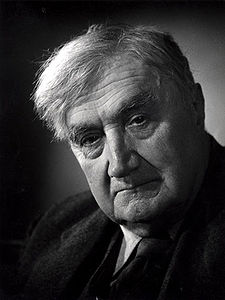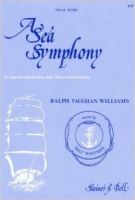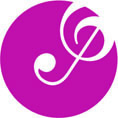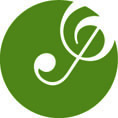Vaughan Williams Sea Symphony Vocal Score
 Vocal Scores for Vaughan Williams' A Sea Symphony
Vocal Scores for Vaughan Williams' A Sea Symphony
The Sea Symphony is a choral symphony by Ralph Vaughan Williams, written between 1903 and 1909.
The most popular vocal score for Vaughan Williams' Sea Symphony is shown below.
Rehearsal recordings to help learn your voice part (Soprano, Alto, Tenor, Bass) are described below.
Full Video Version to hear the work in full is also below
The Stainer and Bell edition of Vaughan Williams' A Sea Symphony is for SATB

Catalogue Number: STAD47
ISMN:9790220217470
Please click here if you wish to order and further vocal score information
Please order by 3pm to be despatched today




Vaughan Williams's first and longest symphony, it was first performed at the Leeds Festival in 1910, with the composer conducting. The symphony's maturity belies the composer's relative youth when it was written (he was 30 when he first began sketching it). One of the first symphonies in which a choir is used throughout the work and is an integral part of the musical texture, A Sea Symphony helped set the stage for a new era of symphonic and choral music in England during the first half of the 20th century.
The work is sometimes referred to as the Symphony No. 1.
.
From 1903 to 1909, Ralph Vaughan Williams worked intermittently on a series of songs for chorus and orchestra that were to become his most lengthy project to date and his first true symphony. Originally titled The Ocean, A Sea Symphony was first performed in 1910 at the Leeds Festival on the composer's 38th birthday. This is generally cited as his first large-scale work; although Grove lists some 16 other orchestral works composed by Vaughan Williams before he completed A Sea Symphony, including two with chorus; the vast majority of those are juvenilia or apprentice works that have never been published and are long since withdrawn from circulation. Nevertheless, Vaughan Williams had never before attempted a work of quite this duration, or for such large forces, and it was his first of what would eventually be nine symphonies. Like Brahms, Vaughan Williams delayed a long time before composing his first symphony, but remained prolific throughout the end of his life: his final symphony was composed from 1956–58, and completed when he was 85 years of age.
At approximately 70 minutes, A Sea Symphony is the longest of all Vaughan Williams’s symphonies. Although it represents a departure from the traditional Germanic symphonic tradition of the time, it follows a fairly standard symphonic outline: fast introductory movement, slow movement, scherzo, and finale. The four movements are:
* A Song for All Seas, All Ships (baritone, soprano, and chorus)
* On the Beach at Night, Alone (baritone and chorus)
* Scherzo: The Waves (chorus)
* The Explorers (baritone, soprano, semi-chorus, and chorus)
The first movement lasts roughly twenty minutes; the inner movements approximately eleven and eight minutes, and the finale lasts roughly thirty minutes.
The text of A Sea Symphony comes from Walt Whitman's Leaves of Grass. Though Whitman's poems were little known in England at the time, Vaughan Williams was attracted to them for their ability to transcend both metaphysical and humanist perspectives. Whitman's use of free verse was also beginning to make waves in the compositional world, where fluidity of structure was beginning to be more attractive than traditional, metrical settings of text. Vaughan Williams sets the following poems in A Sea Symphony:
* Movement 1: “Song of the Exposition” and “Song for all Seas, all Ships"
* Movement 2: "On the Beach at Night Alone"
* Movement 3: "After the Sea-ship", taken in its entirety
* Movement 4: "Passage to India"
The symphony is scored for soprano, baritone, chorus and a large orchestra consisting of two flutes, piccolo, two oboes, English horn, two clarinets, E-flat clarinet, bass clarinet, two bassoons, contrabassoon, four horns, three trumpets, three trombones, tuba, timpani (F#2–F3), percussion (side drum, bass drum, triangle, suspended cymbal, crash cymbals), two harps, organ, and strings.
In order to facilitate more performances of the work, the full score also includes the provision that it may be performed by a reduced orchestra of two flutes (second doubling piccolo), one oboe, English horn, two clarinets, two bassoons, four horns, three trumpets, three trombones, tuba, timpani, percussion, one harp, and strings.
The baritone soloist sings in movements 1, 2, and 4, and the soprano soloist sings only in 1 and 4.
Comparisons to Stanford, Parry, and Elgar, as in the Grove article, are expected. Not only were the four writing during the same era and in the same country, Vaughan Williams studied with both Stanford and Parry at the Royal College of Music, and his preparations for composing A Sea Symphony included study of both Elgar's Enigma Variations (1898–99) and his oratorio The Dream of Gerontius (1900).
A Sea Symphony is among the best-known of a host of sea-related pieces being written around the same time in England, some of the most famous of which are Stanford's Songs of the Sea (1904) and Songs of the Fleet (1910), Elgar's Sea Pictures (1899), and Frank Bridge's The Sea (1910). Debussy's La Mer (1905) may also have been influential in this apparent nautical obsession.
Vaughan Williams studied with Ravel for three weeks in Paris in 1908. Though he worked chiefly on orchestration, this was to provide quite a contrast to the Germanic tradition handed down through Stanford and Parry at the RCM, and perhaps began to give Vaughan Williams a greater sense for colour and a freedom to move chords as block units. His partiality towards mediant relationships, a unifying harmonic motive of A Sea Symphony, may have been somewhat liberated by these studies, and this harmonic relationship is now considered symptomatic of his style in general. A Sea Symphony also makes use of both pentatonic and whole tone scales, now often considered idiomatic features of French music of the period. Almost certainly, this music was in Vaughan Williams’s mind as he finished work on A Sea Symphony in 1908–1909, however, Ravel paid him the great compliment of calling him “the only one of my students who does not write my music.”
Musically, A Sea Symphony contains two strong unifying motives. The first is the harmonic motive of two chords (usually one major and one minor) whose roots are a third apart. This is the first thing that occurs in the symphony; the brass fanfare is a B flat minor chord, followed by the choir singing the same chord, singing Behold, the... The full orchestra then comes in on the word sea, which has resolved into D major. The second motive is a melodic figure juxtaposing duplets and triplets, set at the opening of the symphony (and throughout the first movement) to the words And, on its limitless heaving breast... In the common method of counting musical rhythms, the pattern could be spoken as 'one two-and three-two-three four', showing that the second beat is divided into eighth notes (for on its) and the third beat is divided into triplets (for limitless).
The impact of A Sea Symphony manifests itself not only in the life of the composer (his first symphony and first work of such an immense scale), but also in the newfound support and appreciation of the English symphony and 20th century English music in general. Hugh Ottaway's book, Vaughan Williams Symphonies presents the following observation in its introduction:
“The English symphony is almost entirely a twentieth-century creation. When in 1903 Vaughan Williams began to sketch the songs for chorus and orchestra that became A Sea Symphony, Elgar had not yet emerged as a symphonist. And, extraordinary though it may seem, Elgar's First (1908) is the earliest symphony by an English composer in the permanent repertory. . . By the time Vaughan Williams had completed his Ninth [Symphony] – in 1958, a few months before his death at the age of 85 – the English symphony . . . had become a central figure of our musical revival. To say that Vaughan Williams played a major part in bringing this about is to state the obvious: throughout much of the period he was actively involved in English musical life, not only as a composer but as a teacher, conductor, organiser and, increasingly, advisor of young men.”
In the Grove article on Vaughan Williams, Ottaway and Frogley call the work:
“…a triumph of instinct over environment. The tone is optimistic, Whitman's emphasis on the unity of being and the brotherhood of man comes through strongly, and the vitality of the best things in it has proved enduring. Whatever the indebtedness to Parry and Stanford, and in the finale to Elgar, there is no mistaking the physical exhilaration or the visionary rapture.”
Ursula Vaughan Williams, in what has become the definitive biography of her husband Ralph Vaughan Williams, writes of his philosophy in a more general sense:
“…he was aware of the common aspirations of generations of ordinary men and women with whom he felt a deep, contemplative sympathy. And so there is in his work a fundamental tension between traditional concepts of belief and morality and a modern spiritual anguish which is also visionary.”
(Article based on the Wikipedia entry for Vaughan Williams' Sea Symphony)
For further information of Vaughan Williams' A Sea Symphony, please click here to visit the Wikipedia website




ChoraLine 'Voice Part' Rehearsal CDs & EasyPlay (Stream & Download)
Quick and Easy way to memorise your vocal line and practise between choir rehearsals

Know Your Notes Perfectly
Enhance Your Enjoyment when Singing
Learn With The Music
Shine In Your Choir
Sing With Confidence
Please click here to hear a ChoraLine sample for A Sea Symphony




If you wish to have a CD of A Sea Symphony to hear the whole work please click here and please do click on the video below to listen right away if you wish




